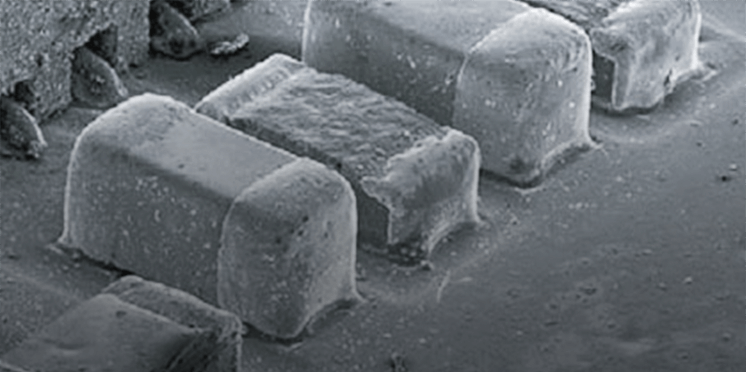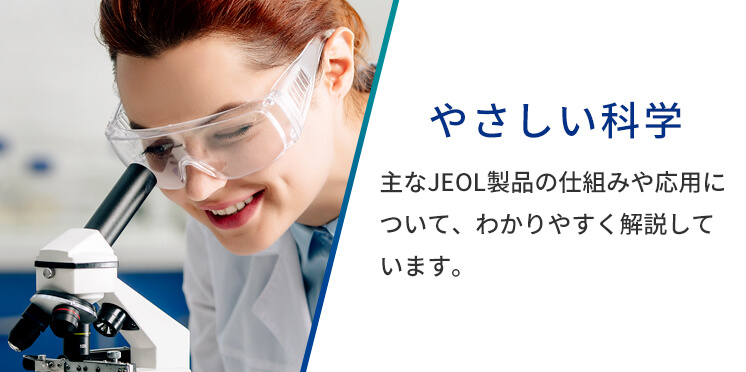走査電子顕微鏡
走査電子顕微鏡
scanning electron microscope, SEM
[目次:理論(電子の散乱/回折/結像)]
バルク試料の表面を微小電子プローブで走査し、表面から放出される二次電子や反射電子を検出器で受け、その強度をプローブ走査に同期させて、コンピュータモニタ上に輝点列の像として表示する電子顕微鏡。二次電子からバルク試料表面の微細な構造や形態が、反射電子から組成の違いを観察できる。EDSやWDSをはじめとする様々な分析機能を付加して使われている。SEMの分解能を決める重要な要素は入射ビームの試料上でのプローブサイズである。プローブサイズを小さくするには第一に電子源の大きさを小さくすることである。搭載されている電子銃が冷陰極型電解放出型電子銃,ショットキー型電子銃,LaB6電子銃,タングステン電子銃の順でプローブサイズは大きくなる。第二に対物レンズのタイプによって絞れるビームサイズが決まる。対物レンズには1)アウトレンズ、2)シュノーケルレンズ、3)インレンズがある。アウトレンズ型では大きな試料を傾斜しても像が得られるように、試料を対物レンズの下方に置く。試料に対する制限がゆるい代わりにレンズの焦点距離が長くなり小さいビームは得られにくい。インレンズ型ではTEMのように対物レンズ中に試料を挿入する。焦点距離を短くでき小さなプローブが得られる。ただし、試料の大きさは数mmに制限される。シュノーケル型(潜水用具に形が似ていることによる命名)は前二者の中間的存在で、試料はレンズの下に置かれ,比較的小さいプローブと比較的大きい試料を扱えるように設計されている。低い加速電圧では色収差の効果により分解能は下がる。分解能は加速電圧20~30kVで定義されている。分解能の具体的数値は,超高分解能型で約1nm、汎用型で10nm程度。Csコレクタ、Ccコレクタを使用すると入射ビームの微小化が可能であるが、取り込み角が大きくなるために焦点深度が浅くなりすぎる欠点がある。入射電子の加速電圧を下げると電子の進入深さが減り,反射電子によって生成される二次電子の空間的な広がりが減るために像のコントラストが向上する。低加速の利点はバックグラウンドの減少のほかに帯電の減少、試料損傷の減少がある。SEMでは帯電が像の質を落とす。入射電子量が流出電子量を上回ると帯電が起き、像が乱れ異常なコントラストが形成される。非伝導性試料の場合には,帯電防止のために貴金属やAl,Cのコ−ティングが行われる。低真空SEMではコーティングなしに非伝導性試料を観察できる場合もある。
An electron microscope in which a small electron probe is scanned over the surface of a bulk specimen, and secondary or backscattered electrons emitted from the surface are collected by a detector, and finally, the intensity of the detected signal is displayed on a computer monitor screen as a series of bright spots synchronized with the scan of the electron probe. An image formed by secondary electrons enables us to observe the fine structure or morphology of the surface of the bulk specimen, whereas an image formed by backscattered electrons provides the difference in the composition of the specimen. The "scanning electron microscope (SEM)" is used by adding various analytical functions (tools) such as EDS and WDS. An important factor that determines the SEM resolution is the size of the incident electron probe (beam) on the specimen. To decrease the probe size, the most essential point is to decrease the size of the electron (emission) source. The cold cathode FEG has the smallest source size, followed by the Schottky FEG, the LaB6 (tip) electron gun, and the tungsten (filament) electron gun. The second most essential point that determines the probe size is the selection of the objective lens. Three types of objective lenses are available; (1) out-lens type, (2) snorkel lens type, and (3) in-lens type. In the out-lens type, a specimen is placed below the objective lens allowing tilting a large specimen. In this lens, limitation on specimen size is not severe but the production of a small beam is difficult because the focal length of the lens becomes large. In the in-lens type, a specimen is inserted into the objective lens in the same manner as the TEM. In this lens, a small probe can be produced because the focal length can be made small. However, the specimen size is limited to several mm. The snorkel lens has a compromise design between the out-lens and in-lens. (The term, "snorkel," originates from the fact that the lens geometry resembles a snorkel used by divers.) A specimen is placed below (not far from) the objective lens. Thus, a relatively small probe can be produced and also a relatively large specimen can be treated. The SEM resolution is degraded at low accelerating voltages due to the chromatic aberration effect. Normally, the resolution is defined at 20 to 30 kV. An ultra-high resolution SEM achieves a resolution of about 1 nm, whereas a general-purpose SEM provides a resolution of about 10 nm. The use of a Cs corrector or a Cc corrector enables a further decrease of the incident-beam size, but causes a disadvantage of a short focal depth because the acceptance angle becomes larger. As the accelerating voltage of the incident electrons is decreased, the penetration depth of the electrons becomes smaller. This reduces a spread of secondary electrons generated by backscattered electrons in the specimen, thus enhancing the image contrast. Advantages of low accelerating voltage include the reduction of the background in the image, the decrease of charging, and the decrease of damage to the specimen. In SEM, charging degrades the image quality. If the current of the incident electrons exceeds the current of electrons flowing out of the specimen, charging takes place. The charging disturbs the image, sometime forming nothing like the true image. When a nonconductive specimen is used, to prevent charging, the specimen is coated with a conductive material, such as noble metal, Al and C. In a low-vacuum SEM, a nonconductive specimen may be observed without coating.
関連用語から探す
説明に「走査電子顕微鏡」が含まれている用語






